Sharks in a volcano !
Sharkcano - Scientists filming unexplored depths of the South Pacific have observed a surprising range of animals—including sharks, rays, and jellyfish—living inside Kavachi, a highly active undersea volcano near the Soloman Islands, a remote archipelago east of Papau New Guinea. The animals seem unruffled by what were presumed inhospitable temperatures and acidity.
Sharkcano - Scientists filming unexplored depths of the South Pacific have observed a surprising range of animals—including sharks, rays, and jellyfish—living inside Kavachi, a highly active undersea volcano near the Soloman Islands, a remote archipelago east of Papau New Guinea. The animals seem unruffled by what were presumed inhospitable temperatures and acidity.
 |
| Scaleless Blackfish, Australia |
The more we learn about undersea volcanoes, the more we realize that life can thrive almost anywhere. Now, an Australian research vessel has discovered a new kind of fish living in volcanoes off the coast of the continent. It’s called a scaleless blackfish and it’s adorably ugly.
The team is still trying to identify this tiny blackfish with translucent fangs and no scales (also it’s not clear whether it’s an adult or larva). But there were a lot of other fish they could identify — mostly because they were larval versions of fish and lobsters that are farmed in Australia. When the larval versions of these animals are swept out of their ocean nurseries into the open sea, farmers assumed that they were lost forever. They were wrong.
It turns out that they are thriving, and growing up in the warm, acidic waters near underwater volcanoes.
According to the chief scientist for the voyage, UNSW marine biologist Professor Iain Suthers, the team were amazed to discover an eddy off Sydney that was a hotspot for lobster larvae and other tiny critters, at a time of the year when they were not expecting them.
This discovery turned the previous understanding of juvenile commercial fish species on its head.
“We had thought fish only developed in coastal estuaries, and that once larvae were swept out to sea that was end of them. But in fact, these eddies are nursery grounds for commercial fisheries along the east coast of Australia.



No comments:
Post a Comment